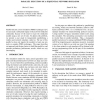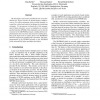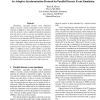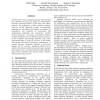WSC
2000
14 years 7 months ago
2000
Parallel discrete event simulation (PDES) techniques have not yet made a substantial impact on the network simulation community because of the need to recast the simulation models...
WSC
2004
14 years 7 months ago
2004
The concept of operations for a micro-UAV system is adopted from nature from the appearance of flocking birds, movement of a school of fish, and swarming bees among others. This &...
WSC
2007
14 years 8 months ago
2007
In this paper we describe a technique for efficient parallelization of digital wave guide network (DWN) models based on an interpretation of the finite difference time domain (F...
PADS
1996
ACM
14 years 10 months ago
1996
ACM
We investigate conservative parallel discrete event simulations for logical circuits on shared-memory multiprocessors. For a first estimation of the possible speedup, we extend th...
ANSS
1998
IEEE
14 years 10 months ago
1998
IEEE
Simulation, especially discrete event simulation (DES), is used in a variety of disciplines where numerical methods are difficult or impossible to apply. One problem with this met...
PADS
2000
ACM
14 years 10 months ago
2000
ACM
The simulation of wide area computer networks is one area where the benefits of parallel simulation have been clearly demonstrated. Here we present a description of a system that...
PADS
2004
ACM
14 years 11 months ago
2004
ACM
Parallel discrete event simulation techniques have enabled the realization of large-scale models of communication networks containing millions of end hosts and routers. However, t...
PADS
2005
ACM
14 years 11 months ago
2005
ACM
Neural systems are composed of a large number of highly-connected neurons and are widely simulated within the neurological community. In this paper, we examine the application of ...
PADS
2006
ACM
14 years 12 months ago
2006
ACM
A master/worker paradigm for executing large-scale parallel discrete event simulation programs over networkenabled computational resources is proposed and evaluated. In contrast t...




